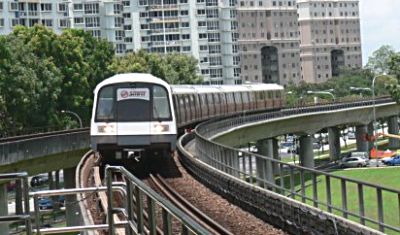This article by James Chong is republished from his blog (The Secret Investors) with permission.
 Temasek Holdings is buying out the 'troubled' transport firm SMRT at S$1.68, valuing the company at about S$2.56B. Because Temasek owns 54.1%, it has to pay about S$1.18B for the remaining stake.
Temasek Holdings is buying out the 'troubled' transport firm SMRT at S$1.68, valuing the company at about S$2.56B. Because Temasek owns 54.1%, it has to pay about S$1.18B for the remaining stake.
Readers of my blog would have known I bought SMRT back in 2014 at an average cost of about $1.02 and sold in the same year at $1.49. I left a comment and highlighted that the non-fare segment of the company seemed attractive as follows:
Some SMRT Non-Rail Results



All 3 segments have shown marked and consistent increase in both the topline and operating results (total in 2016: S$123M) over the past 6 years. The total operating profit for the Rail & Non-Rail Segments is S$142.6M. That means the 3 biggest Non-Rail segment is >85% of the total Non-Rail and Rail operating results.
| ♦ Non-rail business segments doing fine |
 "All 3 of the largest non-rail segments have shown marked and consistent increase in both the topline and operating results (total in 2016: S$123M) over the past 6 years. The total operating profit for the Rail & Non-Rail Segments is S$142.6M. That means the 3 biggest Non-Rail segment is >85% of the total Non-Rail and Rail operating results." "All 3 of the largest non-rail segments have shown marked and consistent increase in both the topline and operating results (total in 2016: S$123M) over the past 6 years. The total operating profit for the Rail & Non-Rail Segments is S$142.6M. That means the 3 biggest Non-Rail segment is >85% of the total Non-Rail and Rail operating results."-- James Chong (photo) |
I think it is not unreasonable to expect that the Non-Rail segments will do quite well in the foreseeable future. These 3 very profitable, inherently stable and growing segments combined could probably be worth about S$1.7B (this is only a quick and dirty estimate of 13X - 15X operating profit). Also take note that there are other Non-Rail segments that may be of some value as well (classified as Engineering Services, Other Services and Investment Holding and Support Services).
I'm not so sure why the focus out there is on the Rail segment and why the management has not expressed any thoughts on the striving Non-Rail segment with regards to the buyout offer. But from the standpoint of the investor and those who are supposed have a duty to look after shareholders' interest, it is unwise to focus solely on the Rail segment and keep harping about the Rail's corresponding risk.
There seems to be much confusion whether SMRT Rails should be more concerned with the investors' interest or the public's. Also, Chief Executive Desmond Kuek (former army general) said that "significant risks remain and many factors are outside the control of SMRT such as uncertainty over future fare increases and ridership numbers."
I'm not so sure how 'significant' the risk for the rail segment is in the future despite being relieved of their heavy operating assets under the new Rail Financing Framework. I would hazard a guess that both fare and ridership numbers will at least remain stable and it is likely that operations will be less risky compared to before the implementation of the framework.
| ♦ Proposed Solution |
| 1. Since the focus of the buyout seemed to be on the Rail segment: spin out the Non-Rail segments so that their proper value can be realized by the market. Existing shareholders should be more than happy to then sell off the operations of the Rail and Bus segments not owned by Temasek for, say, S$500M (this values the Rail & Bus segments to be about S$1.1B. Assuming the above valuation of $1.7B for the 3 Non-Rail segments are correct, SMRT could potentially be worth in excess of S$2.8B which corresponds to a price of about S$1.84 per share). 2. Offer a (higher) price that truly reflects the value of both the Rail & Non-Rail segments. (I read in the news that in the past 10 odd years, SMRT's price averaged about S$1.64. Offered price is S$1.68. Obviously some shareholders might be unhappy with the current offer). Advantages are two-fold: 1. Rail and Bus assets out of the way and privatized - the role of a public transport operator can be better fulfilled in the long term without taking the pressure of short-term market expectations. 2. With the Rail segment out, the market can more easily discern the true value of the remaining Non-Rail entities. Not only can shareholders receive some cash from the disposal, they would probably be very pleased to have their hands on a growing and very profitable Non-Rail segment. |
Some Things to Work Out
Now, the Advertising and Rental businesses are obviously highly intertwined with the Rail business. Therefore, the question to ask is if the above solution is possible at all? I'll leave these to the shareholders and management to answer for themselves. It's tough, but a fair and equitable solution should be created for all parties involved.
James Chong is self-employed and began his investing journey exploring various approaches to stock investments, incurring huge losses on the way. He now sticks to a core investment philosophy and has since recouped the losses while earning a decent overall profit. He believes that a high price can turn stocks of good quality businesses into a speculative purchase and likewise, a low price can turn a speculative stock into an attractive investment.






The key ideas to bring across is that:
1. There is too much focus (or distractions) on the Rail segment out there
2. The Non-Rail segments are very much neglected and probably valuable and worth a look.
3. There could be better solutions out there but of course issues need to be ironed out.
Without the assets, there is no advertising revenue? The part of the cost associated with the advertising segment is in the depreciation of the assets. Therefore, selling the advertising segment without owning the asset will result in rental payment for the advertising space. Buyer of the advertising segment may end up at the mercy of the owner of the rail and bus asset for rental of space for the advertisements. This could drive up their operating cost.
Without the bus and rail assets, there is no advertising business to consider.